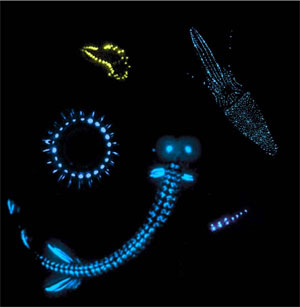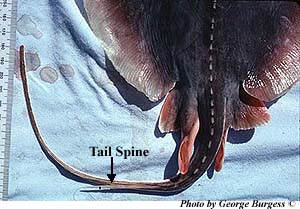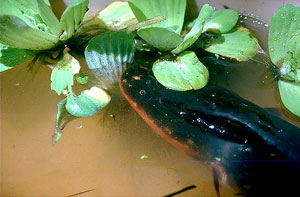Coloration
Fish display a wide variety of colors and color patterns. Skin coloration can have many functions. Many fish have color patterns that help them blend in with their environment. This may allow the fish to avoid being seen by a predator. Some fish, such as the flat fishes (Pleuronectiformes), can change their skin coloration to match the surrounding habitat.

Gulf flounder (left), family Paralichthyidae, and Wide-eyed flounder (right), family Bothidae. Photos © James L. Van Tassell and David Snyder
Fish can also have disruptive markings to hide body parts. Species such as the jackknife fish (Equetus lanceolatus), high-hat (Equetus acuminatus) and some angel fishes (Pomacanthidae), have dark lines that run through the eyes. These lines may serve to hide the eyes so that other animals can not tell where the fish is looking or even if it is a fish. Also, horizontal lines may be a sight-line for aiming attacks on prey. Some fishes, like butterflyfishes (Chaetodontidae), have spots on their body that resemble eyes. This may serve to confuse prey and predators alike. In addition to coloration, some fish, like the sea dragon (Phyllopteryx), have body shapes that can further mimic their habitat.

Foureye butterflyfish, family Chaetodontidae (left), and High-hat, family Sciaenidae (right). Photos © Luiz Rocha and David Snyder
Fish coloration can also be useful in catching prey. Many sharks exhibit coloration known as counter shading. Sharks that have counter shading are dark on the dorsal (upper) side and light on the ventral (lower) side. With this color scheme any prey looking down on the shark will see a dark shark against a dark sea bottom, making it hard to detect the shark. Conversely, any prey looking up at the shark, will see the light belly of the shark on the light background of the ocean surface water lit by the sun or moon.

Coloration can also be used to advertise. Fishes like the darters (Percidae) and sticklebacks (Gasterosteus), may use color to attract and recognize potential mates.

Light Organs
Some marine fish have the ability to produce light through bioluminescence. Most light-producing fish live in mid-water or are bottom-dwelling deep sea species. In fish, bioluminescence can occur two different ways: through symbiotic bacteria living on the fish or through self-luminous cells called photophores. Some species of deep sea angler fish (Lophiiformes) may use this light to attract prey, while others, like the Atlantic midshipman (Porichthys plectrodon), may use this light to attract mates.

Venom
Many fish may use venom as a form of defense. Most venomous fish deliver the toxins through the use of a spine. Venomous spines are found in a wide variety of fish including stingrays, chimaeras, scorpionfishes, catfishes, toadfishes, rabbit fishes, and stargazers. Venomous spines can have poison glands along the grove of the spine, as with stingrays, or at the base of the spine, as in some catfish. While humans can be stung by a multitude of fishes, few species are life-threatening.

Electric Organs
Elasmobranchs (sharks, skates, and rays) possess an electric sense system known as the ampullae of Lorenzini. This system consists of many tiny gel-filled canals positioned on the head of the fish. Through this system these fishes are able to detect the weak electric fields produced by prey. It is also believed that these fish can use this sense to detect the electric fields they induce when swimming through the earth’s magnetic field, as a sort of compass. Since the fishes are able to generate the fields they detect, this is a form of active electro-orientation.
Some species of skates and rays also have electricity-producing organs. The electric rays have paired electric organs located on either side of the head, behind the eyes. With these organs, electric rays are able to shock and stun their prey. The skate’s electric organs are located near the tail. However, these electric organs only produce weak electric fields not capable of stunning prey. Researchers believe that the skate’s electric organs are used for communication and mate location.

The electric eel can also produce electric fields. These eels use weak electric fields for navigation, prey location, and communication. Additionally, these eels can produce strong electric fields to stun potential prey. The strength of the “shock” is related to the size of the eel, with larger individuals being able to produce more of a “shock.”

Prepared by: Andrew Piercy